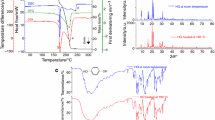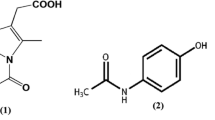ABSTRACT
Purpose
(i) To investigate buffer salt crystallization and the consequent pH shifts during the freezing stage of the lyophilization of indomethacin sodium (IMCNa) in aqueous sodium phosphate buffer. (ii) To determine the effect of pH shift on the disproportionation of IMCNa in lyophilized formulations.
Methods
Prelyophilization solutions containing IMCNa in sodium phosphate buffer, at initial buffer concentrations ranging from 10 to 100 mM (pH 7.0), and at IMCNa concentrations of 5, 10 & 15 mg/ml, were investigated. Their phase behavior during cooling was monitored by low temperature X- ray diffractometry (XRD), differential scanning calorimetry (DSC) and pH measurements. The final lyophiles were characterized by infrared spectroscopy (IR) and XRD.
Results
Upon cooling to −25°C, pronounced pH shifts were observed only in IMCNa buffered solutions containing high initial buffer concentration (100 mM), due to crystallization of Na2HPO4.12H2O. In the final lyophiles, disproportionation of IMCNa to the free acid (IMC) was observed in systems with buffer concentrations ≥50 mM, but not low buffer concentration (10 mM). At intermediate buffer concentrations (35 & 20 mM) the disproportionation depended on IMCNa concentration. The initial concentrations of both buffer and IMCNa influenced the buffer crystallization.
Conclusions
During freeze drying, selective crystallization of a buffer component and the consequent pH shift can cause disproportionation of IMCNa. This can prolong the reconstitution time or retain particles of the poorly soluble free acid in the reconstituted solution.










Similar content being viewed by others
Abbreviations
- API:
-
Active pharmaceutical ingredient
- DI:
-
Deionized water
- DSC:
-
Differential scanning calorimetry
- EMF:
-
Electromotive force
- FT-IR:
-
Fourier-transform infrared spectroscopy
- IMC:
-
Indomethacin
- IMCNa:
-
Indomethacin sodium
- IR:
-
Infrared spectroscopy
- NaP:
-
Sodium phosphate buffer
- XRD:
-
Powder x-ray diffractometry
REFERENCES
Bross PF, Kane R, Farrell AT, Bross PF, Kane R, Farrell AT, et al. Approval Summary for Bortezomib for Injection in the Treatment of Multiple Myeloma. Clin Cancer Res. 2004;10(12):3954–64.
Thakral S, Suryanarayanan R. Salt formation during freeze-drying - an approach to enhance indomethacin dissolution. Pharm Res. 2015;32(11):3722–31.
van den Berg L, Rose D. Effect of freezing on the pH and composition of sodium and potassium phosphate solutions: the reciprocal system KH2PO4-Na2HPO4-H2O. Arch Biochem Biophys. 1959;81(2):319–29.
Gomez G, Pikal MJ, Rodriguez-Hornedo N. Effect of initial buffer composition on pH changes during far-from-equilibrium freezing of sodium phoaphate buffer solutions. Pharm Res. 2001;18(1):90–7.
Szkudlarek BA. Selective crystallization of phosphate buffer components and pH changes during freezing: Implication to protein stability. Ph.D. Thesis, University of Michigan. 1997.
Sundaramurthi P, Shalaev E, Suryanarayanan R. “pH Swing” in Frozen Solutions—Consequence of Sequential Crystallization of Buffer Components. J Phys Chem Lett. 2010;1(1):265–8.
Sundaramurthi P, Shalaev E, Suryanarayanan R. Calorimetric and Diffractometric Evidence for the Sequential Crystallization of Buffer Components and the Consequential pH Swing in Frozen Solutions. J Phys Chem B. 2010;114(14):4915–23.
Pikal-Cleland KA, Carpenter JF. Lyophilization-induced protein denaturation in phosphate buffer systems: Monomeric and tetrameric β-galactosidase. J Pharm Sci. 2001;90(9):1255–68.
Hora MS, Rana RK, Smith FW. Lyophilized formulations of recombinant tumor necrosis factor. Pharm Res. 1992;9(1):33–6.
Hill JP, Dickinson MF. Enzyme storage—to freeze or not to freeze? Biochem Soc Trans. 1989;17(6):1079–80.
Lam XM, Costantino HR, Overcashier DE, Nguyen TH, Hsu CC. Replacing succinate with glycolate buffer improves the stability of lyophilized interferon-gamma. Int J Pharm. 1996;142(1):85–95.
Larsen SS. Studies on stability of drugs in frozen systems. IV. The stability of benzylpenicillin sodium in frozen aqueous solutions. Dan Tidsskr Farm. 1971;45(9):307–16.
te Booy MPWM, de Ruiter RA, de Meere ALJ. Evaluation of the Physical Stability of Freeze-Dried Sucrose-Containing Formulations by Differential Scanning Calorimetry. Pharm Res. 1992;9(1):109–14.
Stephenson GA, Aburub A, Woods TA. Physical Stability of Salts of Weak Bases in the Solid-State. J Pharm Sci. 2011;100(5):1607–17.
Zannou EA, Ji Q, Joshi YM, ATM S. Stabilization of the maleate salt of a basic drug by adjustment of microenvironmental pH in solid dosage form. Int J Pharm. 2007;337(1):210–8.
Merritt JM, Viswanath SK, Stephenson GA. Implementing Quality by Design in Pharmaceutical Salt Selection: A Modeling Approach to Understanding Disproportionation. Pharm Res. 2012;30(1):1–15.
Rohrs B, Thamann T, Ping G, Stelzer D, Bergren M, Chao R. Tablet Dissolution Affected by a Moisture Mediated Solid-State Interaction Between Drug and Disintegrant. Pharm Res. 1999;16(12):1850–6.
Williams AC, Cooper VB, Thomas L, Griffith LJ, Petts CR, Booth SW. Evaluation of drug physical form during granulation, tabletting and storage. Int J Pharm. 2004;275(1):29–39.
Unger EF. Weighing Benefits and Risks — The FDA ’ s Review of Prasugrel. N Engl J Med. 2009;361(10):942–5.
Koranne S, Govindarajan R, Suryanarayanan R. Investigation of spatial heterogeneity of salt disproportionation in tablets by synchrotron X-ray diffractometry. Mol Pharm. 2017;14(4):1133–44.
Guo Y, Byrn SR, Zografi G. Effects of Lyophilization on the Physical Characteristics and Chemical Stability of Amorphous Quinapril Hydrochloride. Pharm Res. 2000;17(8):930–5.
Brien MO, Mccauley J, Cohen E. Indomethacin. In: Florey K, editor. Analytical profiles of drug substances, Vol. 13. New York: Academic Press; 1984. p. 211–8.
James AR. Crystalline sodium and potassium indomethacin and their trihydrates, process for preparing and pharmaceutical compositions containing the same. 1980;EP 0006223 A1. https://www.google.com/patents/EP0006223A1?cl=en
De Marzi S, Morini V. Use of meglumine indomethacin in the treatment of pain due to neoplastic disease. Clin Ter. 1972;62(2):175–80.
Indocin IV. Product Information, Merck, Whitehouse Station, NJ. 2002. https://www.accessdata.fda.gov/drugsatfda_docs/label/2010/018878s027lbl.pdf
Siddiqui A, Rahman Z, Khan SR, Awotwe-otoo D, Khan MA. Root cause evaluation of particulates in the lyophilized indomethacin sodium trihydrate plug for parenteral administration. Int J Pharm. 2014;473(1):545–51.
Jain AK. Solubilization of indomethacin using hydrotropes for aqueous injection. Eur J Pharm Biopharm. 2008;68(3):701–14.
Taylor LS, Zografi G. Spectroscopic characterization of interactions between PVP and indomethacin in amorphous molecular dispersions. Pharm Res. 1997;14(12):1691–8.
Tong P, Zografi G. Solid-state characteristics of amorphous sodium indomethacin relative to its free acid. Pharm Res. 1999;16(8):1186–92.
Aceves-Hernandez JM, Nicolás-Vázquez I, Aceves FJ, Hinojosa-Torres J, Paz M, Castañ OVM. Indomethacin polymorphs: Experimental and conformational analysis. J Pharm Sci. 2009;98(7):2448–63.
Surwase SA, Boetker JP, Saville D, Boyd BJ, Gordon KC, Peltonen L, et al. Indomethacin: New polymorphs of an old drug. Mol Pharm. 2013;10(12):4472–80.
Gomez G. Crystallization-related pH changes during freezing of sodium phosphate buffer solutions. Ph.D. Thesis, University of Michigan. 2000.
Lin S-Y. Isolation and Solid-state Characteristics of a New Crystal Form of lndomet haci n. J Pharm Sci. 1991;81(6):572–6.
Borka L. The polymorphism of indomethacine. New modifications, their melting behavior and solubility. Acta Pharm Suec. 1974;11(3):295–303.
Tong P, Zografi G. A study of amorphous molecular dispersions of indomethacin and its sodium salt. J Pharm Sci. 2001;90(12):1991–2004.
Varshney DB, Kumar S, Shalaev EY, Kang SW, Gatlin LA, Suryanarayanan R. Solute crystallization in frozen systems-use of synchrotron radiation to improve sensitivity. Pharm Res. 2006;23(10):2368–74.
Tong P, Zografi G. Effects of Water Vapor Absorption on the Physical and Chemical Stability of Amorphous Sodium Indomethacin. AAPS PharmSciTech. 2004;5(2):1–8.
Sundaramurthi P, Suryanarayanan R. The effect of crystallizing and non-crystallizing cosolutes on succinate buffer crystallization and the consequent pH shift in frozen solutions. Pharm Res. 2011;28(2):374–85.
Trissel LA. Indomethacin sodium trihydrate. In: Handbook on injectable drugs. 11th ed. Bethesda: American Society of Health-System Pharmacists; 2001. p. 745–6.
Kumar L, Baheti A, Mokashi A, Bansal AK. Effect of counterion on the phase behaviour during lyophilization of indomethacin salt forms. Eur J Pharm Sci. 2011;44(1):136–41.
Nail SL, Jiang S, Chongprasert S, Knopp SA. Fundamentals of freeze-drying. In: Nail SL, Akers MJ, editors. Development and manufacture of protein pharmaceuticals. New York: Kluwer Academic/Plenum Publisher; 2002.
Cavatur RK, Suryanarayanan R. Characterization of Frozen Aqueous Solutions by Low Temperature X-ray Powder Diffractometry. Pharm Res. 1998;15(2):194–9.
Suzuki T, Franks F. Solid–liquid phase transitions and amorphous states in ternary sucrose–glycine–water systems. J Chem Soc Faraday Trans. 1993;89(17):3283–8.
Pikal-Cleland KA, Cleland JL, Anchordoquy TJ, Carpenter JF. Effect of glycine on pH changes and protein stability during freeze-thawing in phosphate buffer systems. J Pharm Sci. 2002;91(9):1969–79.
Wu C, Shamblin S, Varshney D, Shalaev E. Advance understanding of buffer behavior during lyophilization. In: Varshney D, Singh M, editors. Lyophilized biologics and vaccines. New York: Springer; 2015. p. 25–41.
Acknowledgments and Disclosures
SK was partially funded by the 3 M Science and Technology Fellowship. The project was partially supported by the William and Mildred Peters endowment fund. The XRD studies in this work were carried out in the Characterization Facility, University of Minnesota, which receives partial support from NSF through the MRSEC program. We thank Vishard Ragoonanan, PhD for helping with the low temperature pH experiments.
Author information
Authors and Affiliations
Corresponding author
Additional information
Guest Editors: Tony Zhou and Tonglei Li
Electronic supplementary material
ESM 1
(DOCX 718 kb)
Rights and permissions
About this article
Cite this article
Koranne, S., Thakral, S. & Suryanarayanan, R. Effect of Formulation and Process Parameters on the Disproportionation of Indomethacin Sodium in Buffered Lyophilized Formulations. Pharm Res 35, 21 (2018). https://doi.org/10.1007/s11095-017-2310-4
Received:
Accepted:
Published:
DOI: https://doi.org/10.1007/s11095-017-2310-4




